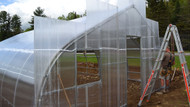Ensure the creation of a proper growing environment. Follow these tips when installing a polycarbonate covering to your greenhouse structure in order to ensure the creation of a proper growing environment.
Handling Polycarbonate
All polycarbonate is supplied with a protective film which should be kept on until the panel is fastened. The UV-protected side should face out towards the sun and is marked with a white or light blue printed film with a sticker that says “MACROLUX coextruded thermoglazing.” Rooflite or Macrolux polycarbonate should be stacked on a flat surface in an area free from sunlight or heat. If polycarbonate is exposed to direct sunlight or high temperatures, this could result in the protective film sticking to the polycarbonate. If the protective film is sticking to the polycarbonate, it can be removed with a solvent, preferably naphtha or isopropyl alcohol. After using the solvent, the polycarbonate should then be cleaned and rinsed thoroughly using a mild soap or detergent.
Measuring & Cutting Polycarbonate
When measuring polycarbonate, always allow ⅛″ for thermal expansion. When cutting polycarbonate, use a saw with a fine tooth blade. Compressed air may be used to remove dust or form channels after cutting.
Hardware use
Use screws with neoprene bonded washers to fasten polycarbonate to greenhouse. Use ½″ washers with corrugated polycarbonate and 1″ washers with triple wall polycarbonate. Do not fasten screws within ½″ of the edge of a polycarbonate sheet. When fastening screws, do not tighten below the surface of the panel. Allow for proper expansion in all drilled holes. The diameter of the hole should be 5/64″ larger than screw size.
Glazing Sheets
Glazing sheets should be joined using either aluminum profiles from Rimol Greenhouse Systems or polycarbonate profiles from Co-Ex. For triple wall polycarbonate, use solid foil tape at the tops of the sheets to seal out water and insects, and foil vented tape at the bottom of the sheets to seal out any insects and allow condensation to drain out of sheets. If you have a spot that needs to be sealed up with silicone, use GE Contactors SCS 1000 Sealant.
Do not over-bend polycarbonate sheets. Minimum bending radius is 150 times the thickness of the panel. When joining sheets of corrugated polycarbonate, allow for one corrugation to overlap. Sheets are 50” wide and will net 48” when overlapped.
Guidelines for Selecting Sheet Thickness and Purlin Spacing
(Sheet Supported on the Four Sides)
Max. Purlin Spacing (Inches) Deflection – 1"
| 4′ Width | ||||
|---|---|---|---|---|
| Load Per Gauge (lb/ft2) | 15 | 30 | 45 | 60 |
| 8mm, 5/16″ | 38″ | 28″ | 18″ | — |
| 6′ Width | ||||
|---|---|---|---|---|
| Load Per Gauge (lb/ft2) | 15 | 30 | 45 | 60 |
| 8mm, 5/16″ | 36″ | 26″ | 12″ | — |
Max. Purlin Spacing (Inches) Deflection – 3"
| 4′ Width | ||||
|---|---|---|---|---|
| Load Per Gauge (lb/ft2) | 15 | 30 | 45 | 60 |
| 8mm, 5/16″ | 80″ | 54″ | 46″ | 40″ |
| 6′ Width | ||||
|---|---|---|---|---|
| Load Per Gauge (lb/ft2) | 15 | 30 | 45 | 60 |
| 8mm, 5/16″ | 60″ | 44″ | 38″ | 34″ |

